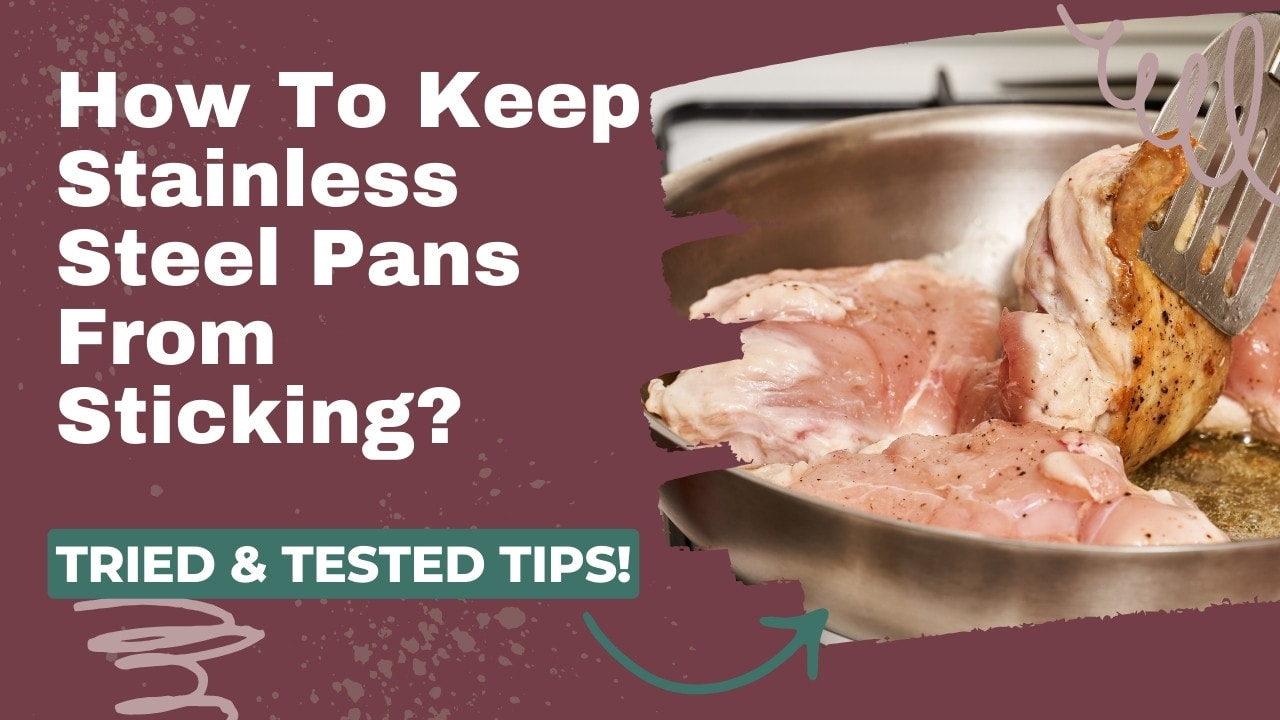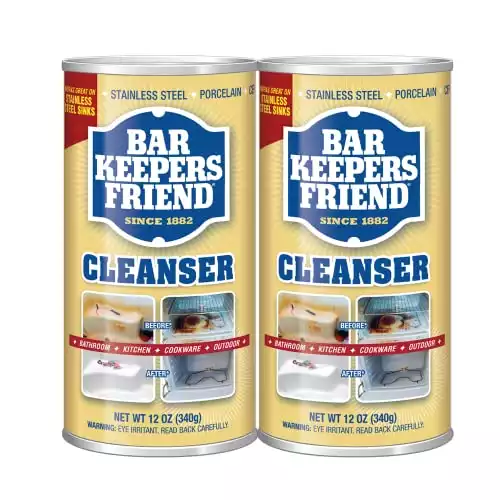When I got my first stainless steel set, I was so excited that I took the pan right out of the box and decided to celebrate with a juicy steak. Much to my disappointment, it stuck to the pan and left me with a brown mush. Then I realized this is not how things are done. After learning the ropes, I’ve never had food stuck to my pans again.
What did I learn? Here’s how you can keep your stainless steel pans from sticking, too.
How Do You Keep Food from Sticking To Stainless Steel Pans?
To cook in stainless steel pans without sticking:
- Start with a perfectly clean pan.
- Preheat the pan before adding ingredients.
- Use the water test to know when the pan is ready.
- Add the right kind of oil.
- Wait until ingredients brown before flipping them.
How to Cook in a Stainless Steel Pan Step-by-Step
1. Choose the Right Size Pan
The first step to frying or searing in stainless steel is picking the right size pan. If the pan is too small, you won’t have enough space for ingredients to brown properly and release from the pan.
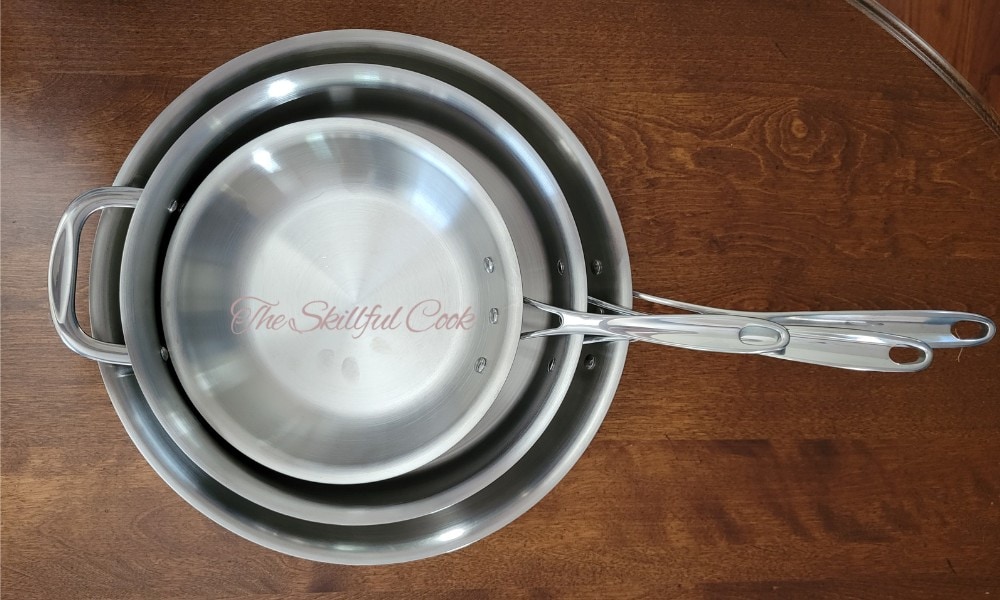
Crowding a pan is one of the main reasons that you get a soggy, gray steak instead of a crispy brown one. You can cook an 8-ounce steak in a 10” skillet. For two, you’ll need a 12” pan.
2. Clean the Pan Thoroughly
In addition to removing visible stuck-on bits of food, you should ensure that there is no oil residue on the pan. Drops of oil left on a pan’s surface create a sticky residue that can burn when you preheat the pan, making food stick.
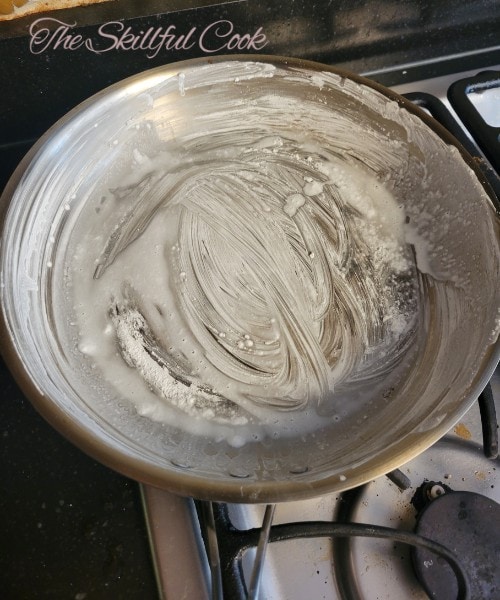
3. Choose the Right Oil
For a stainless steel skillet to behave like it’s nonstick, you need high temperatures. So, you should use an oil with a high smoke point. Most refined oils have a high smoke point since proteins and other impurities have been removed. Refined olive and avocado oil are the best for searing steak or other high-heat cooking. Ghee is another great choice.
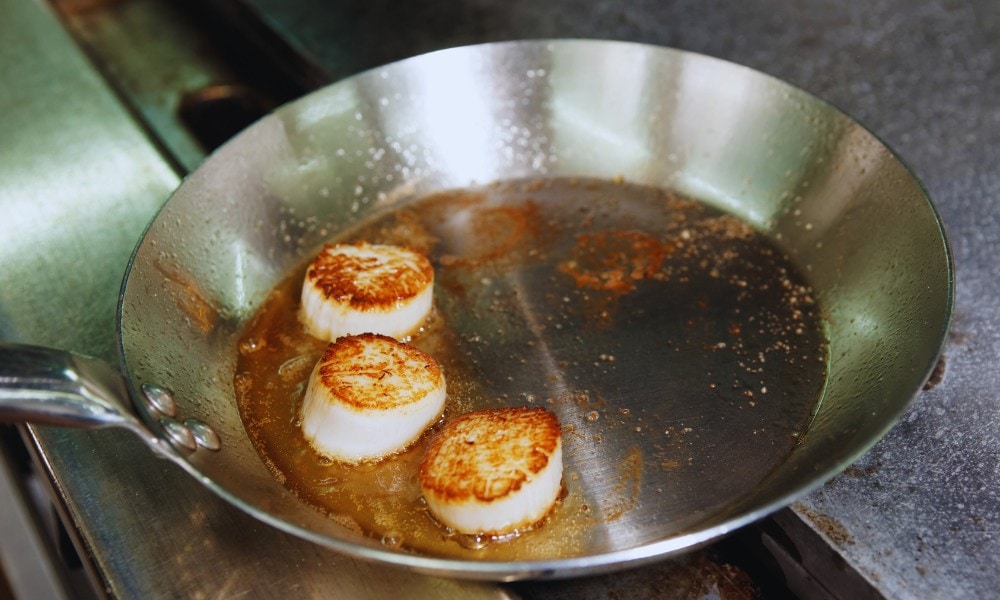
4. Temper Your Ingredients
Bringing ingredients to room temperature is essential to get even cooking, especially in meat. But whether you’re searing steak or frying vegetables, the temperature difference between the pan’s surface and fridge-cold food is considerable. Tempered ingredients take less time to get to the cooking temperature, leading to more even cooking, reduced splattering, and less risk of warping your pan.
5. Preheat the Pan
The single technique that makes or breaks cooking with stainless steel is preheating. If you don’t do it right, your food will stick to your pan – simple as that. Preheating the pan properly helps in two main ways:
- First, it makes the metal expand, forcing the microscopic pores in stainless steel to get even smaller so food can’t get stuck in them.
- Second, food added to a very hot pan will develop a steam barrier that prevents proteins from bonding to the metal. (More on that in the next point.)
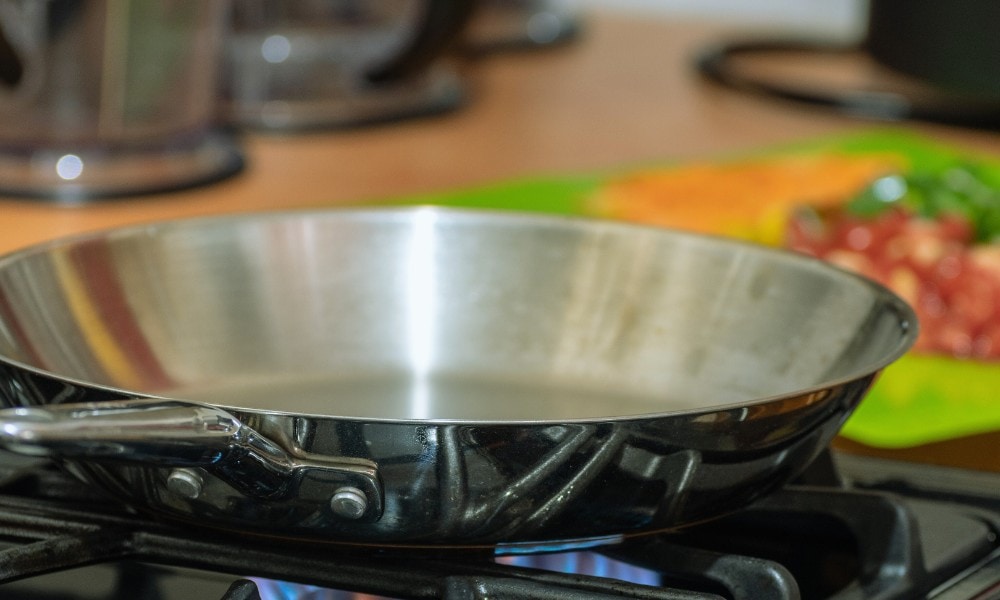
So, place your empty pan over medium heat and wait for it to heat up. Don’t use high heat, as it can lead to overheating.
6. Use the Water Test
Knowing when exactly your stainless steel pan reaches the desired temperature is tricky. It depends on the heat source and your pan’s physical characteristics. A surefire way to figure this out is the water drop test, AKA the mercury ball test.
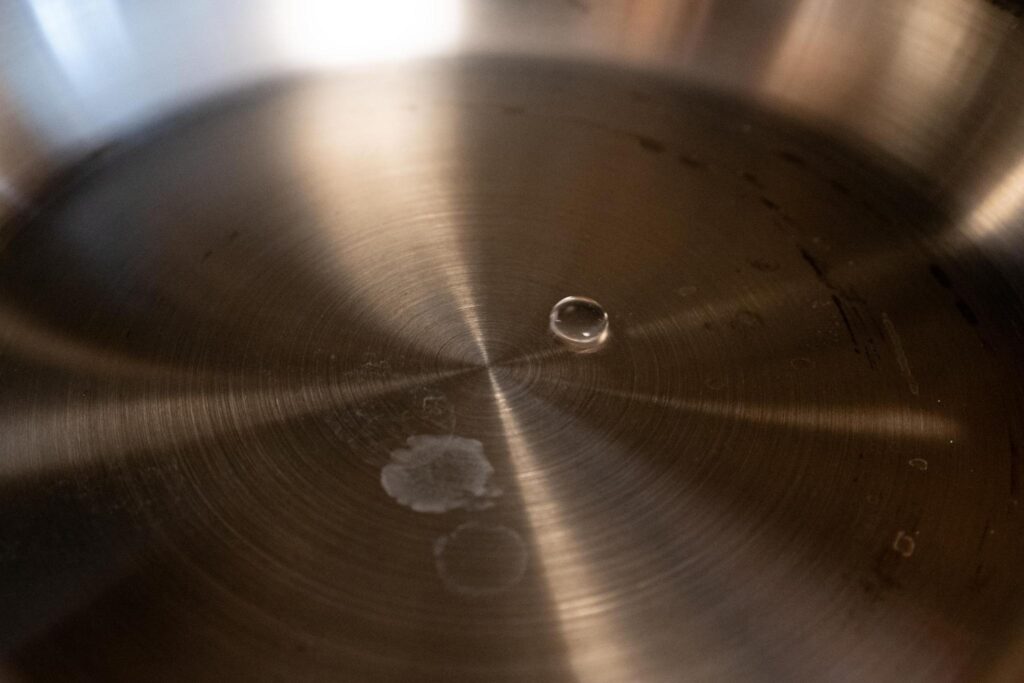
Heat the pan for 2-3 minutes. Sprinkle some water into the pan. Your pan is ready if the water forms a uniform blob sliding over the pan. If it sizzles away, the pan isn’t hot enough to form a steam barrier around the water – or your food. If it breaks into several smaller droplets, it’s too hot.
7. Add Oil and Food
After the pan reaches the right temperature, it’s time to add oil. Lower the heat to prevent overheating and burning. Let the oil heat up for a few seconds, and then add the ingredients. If the meat or other ingredients are wet, dry them with a paper towel. This way, you’ll ensure the moisture doesn’t lower the oil temperature or cause splattering.
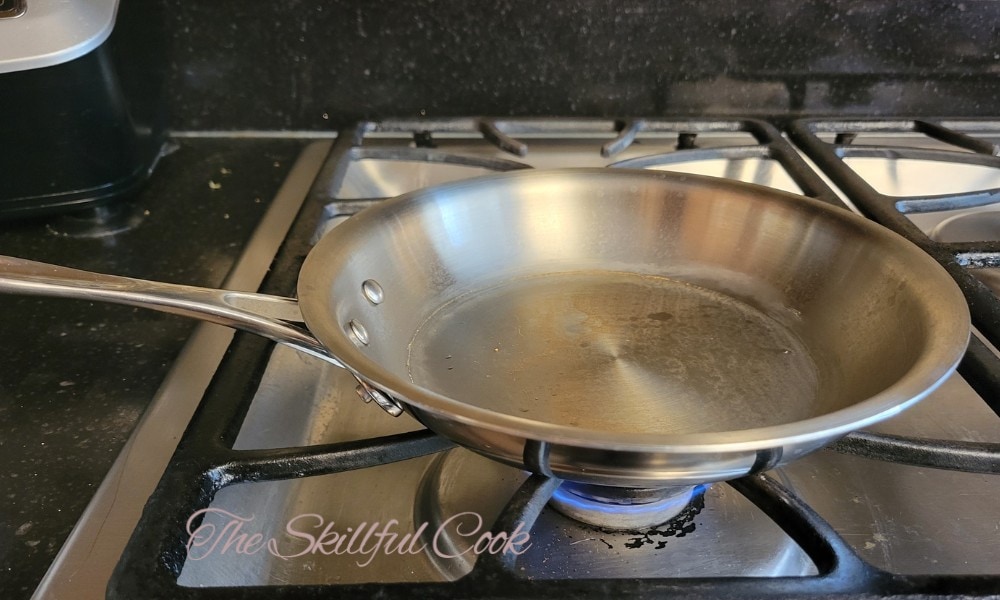
8. Wait for One Side To Brown
Stirring food too soon or too often is one of the biggest mistakes in frying with stainless steel. If you flip your steak or vegetables without waiting for them to brown, they will stick to the pan.
Maintain a medium heat during cooking so that you don’t overheat the food and have to move it around too often. Let it form a nice crust and then turn it. You will feel it release naturally from the pan when it is browned enough.
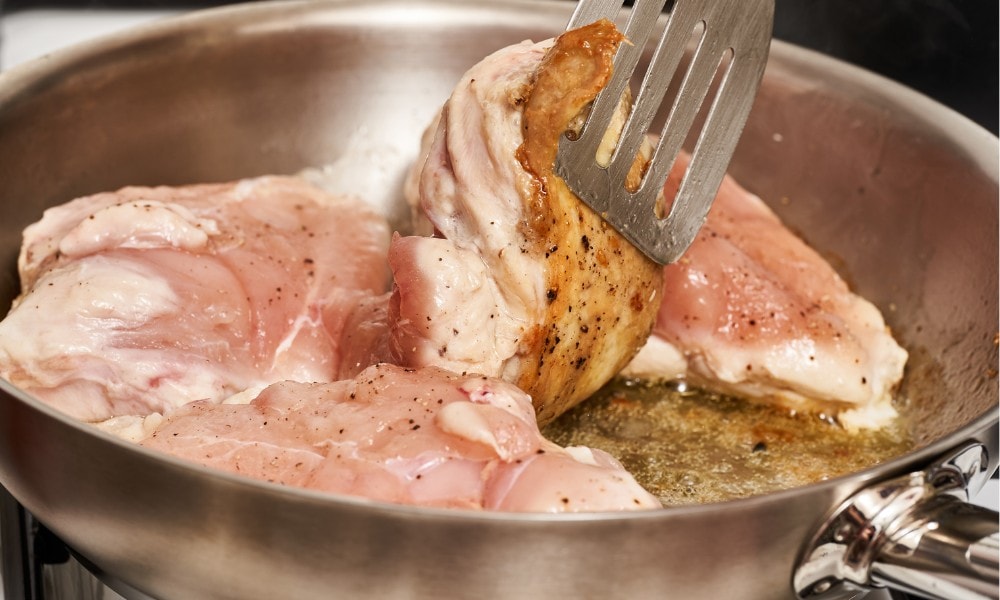
9. Deglaze the Pan
Whether you’re searing vegetables or meat, deglazing is a great way to get the full flavor out of your food. Stainless steel is an ideal material for producing “fond” – or the dark bits of caramelized food that stick to a pan. Deglazing means removing the food once it’s cooked, then adding a bit of broth or wine to the pan and simmering it to create a delicious sauce or gravy. Deglazing also makes cleaning the pan easier.
10. Wash for Next Time
Clean your stainless steel pan shortly after cooking. Remove the pan from the heat source and add warm water. Don’t immerse the pan in cold water when it’s hot, as it can cause warping from thermal shock. Usually, regular dish soap and a soft sponge will do the job. If you have stubborn sticky residue, use Bar Keepers Friend or an acidic cleaner.
Do I Need To Season Stainless Steel?
It isn’t necessary to season stainless steel pans. Seasoning involves forming a naturally nonstick coating on your cookware by baking a thin layer of oil onto its surface. This layer polymerizes then carbonizes and forms a black coating.
Seasoning needs to be done on cookware with a higher iron content, like cast iron and carbon steel. You could perform the same process with stainless steel, but it won’t yield the same results. Stainless steel is every home chef’s sweetheart partly because of its shiny and sleek surface. A blackened layer of burned oil will be the last thing most people want on their beloved stainless steel.
Common Mistakes That Make Food Stick to Stainless Steel
Stainless steel may be notorious for having a learning curve. However, once you get the hang of it, it can be your partner in a lifetime of healthy cooking adventures. Here are the most common pitfalls I’ve seen when learning to cook with stainless steel:
Not Tempering Ingredients
Tempering ingredients is a crucial step, particularly for searing steak. Proteins in cold food can stick to the pan more easily since they drop the temperature of the pan and bond almost immediately.
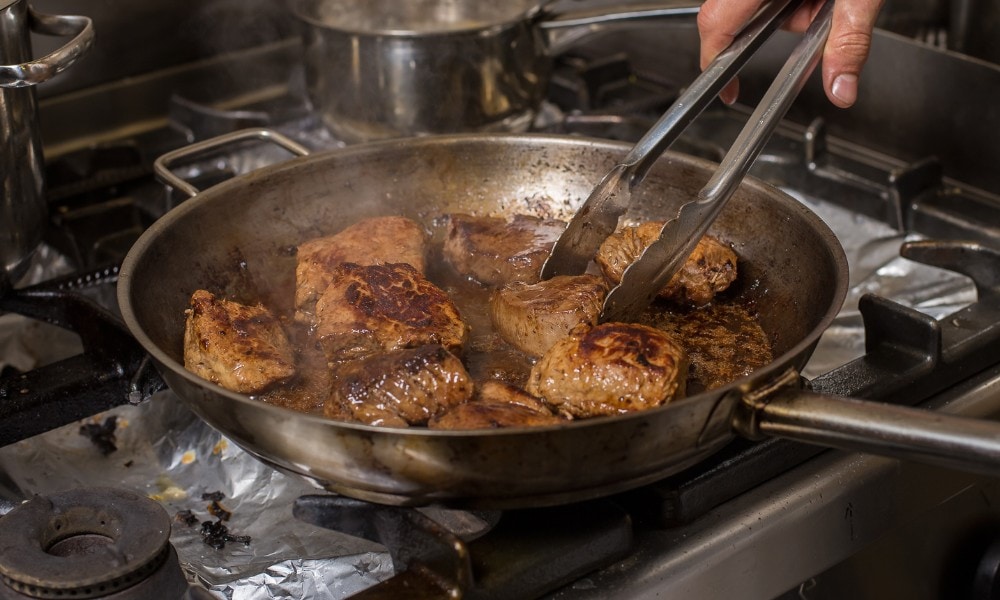
Take your ingredients out of the fridge at least half an hour before cooking to reach room temperature. If you’re in a hurry, put them in a ziplock bag and immerse the bag in warm water for a few minutes. Make sure to follow safe food handling guidelines and not leave it out too long.
Using the Wrong Oil
Many people use butter for searing steak. While it can give your steak a pleasant aroma, it’s not ideal for such high temperatures. Butter has a low smoke point (300°F), which is lower than the ripping hot temperature most people sear steak at (450°F-500°F).
Adding butter or any low-smoke point oil will burn it, releasing free radicals that can be harmful.
Instead of regular butter, use clarified butter since it has a higher smoke point (450°F). Or, be a bit more patient and sear your steak at a lower temperature – it’s totally possible!
You can still enjoy the flavor of butter on your steak by basting it with butter and herbs after searing.
Scrubbing Stainless Steel
Stainless steel can be made non-stick-like, but it will not give you the fully hydrophobic properties of a ceramic or Teflon pan. So, you may still get some stuck-on food that doesn’t come off easily. In such cases, you may be tempted to scrub the pan with steel wool or a scouring pad.
However, scrubbing will deepen the grooves and pores on stainless steel’s surface. These pores make your pan more sticky over time. So, the best way to clean a stainless steel pan is to use natural materials, like vinegar and baking soda. You could make a paste and leave it on the pan, or mix it with water and put it on heat to bring it to a boil.
However, since vinegar is acidic, it can react with stainless steel. Avoid leaving it on the stainless steel cookware for a long time. Or replace it with warm water.
Using the Wrong Utensils
Stainless steel doesn’t have a nonstick coating that gets damaged by metal utensils. However, sharp and metal spatulas and spoons can scratch the pan’s surface, making it harder to clean. The best utensils for stainless steel are silicone and wood.
Not Heating the Oil
After adding the oil to your preheated pan, you should wait for it to heat up for a few seconds. If the oil looks too thick and doesn’t flow across the pan’s surface freely, it’s still too cold. Overheated oil looks rippled and starts to smoke. Sufficiently heated oil is something in between, flowing over the pan like water.
Frequently Asked Questions
Will cooking spray keep stainless steel from sticking?
You shouldn’t use cooking sprays with stainless steel. The chemicals that act as propellants can stick to the pan, and the thin layer of oil in cooking sprays is quick to overheat and polymerize. Instead, you can pour your regular cooking oil into a spray bottle.
Do you need to clean all the brown residue off stainless steel pans?
If the brown residue is on the cooking surface of the pan, yes, it’s necessary. Burned-on oil can form a brown residue on stainless steel and make food stick to the pan. However, if these brown spots are on the underside of the pan, cleaning them is only an aesthetic preference.
Can you cook chicken or meat in stainless steel?
You can cook almost anything in stainless steel, including chicken, beef, pork, fish, or other meats. The right cooking techniques can prevent the protein from sticking to the pan. Preheat your pan for 2-3 minutes, and then add the oil. Wait a few seconds and add the meat. Let it brown before turning. Then deglaze the pan at the end.

